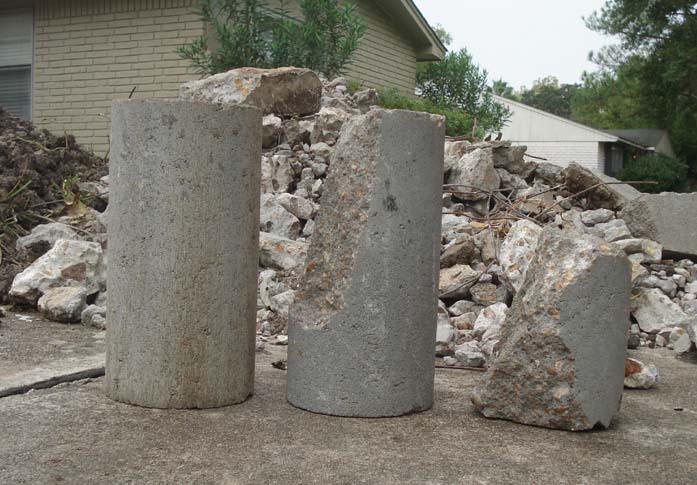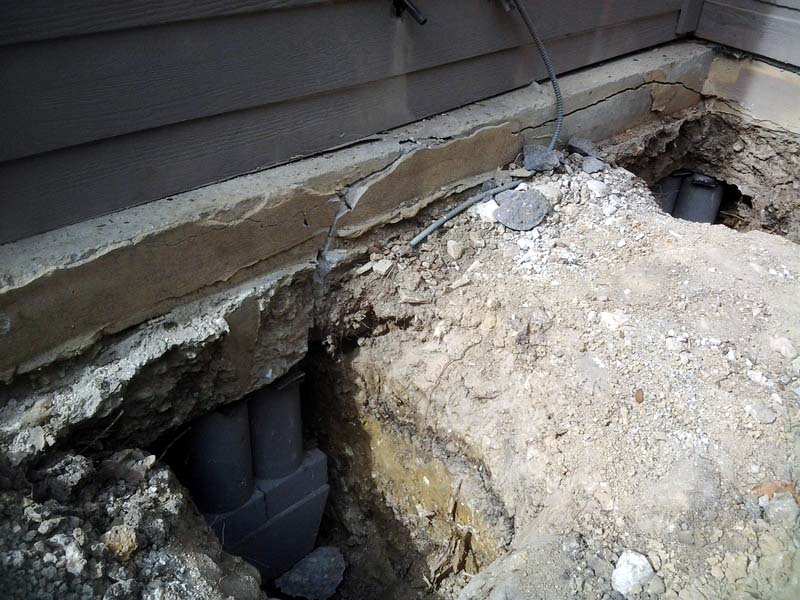We want you to know about the problems / questions / opinions about the method of repair used by most foundation repair contractors in the state of Texas. Don’t listen to us. Listen to independent Structural Engineers who have experience with concrete slab foundations. They know what works and what doesn’t work. Their opinion below is that concrete pressed piles do not meet Building Codes in the state of Texas. Please read what the independent structural engineers at A-1 Engineering have to say about Pressed Piles. Then you can read the studies, reports, and concerns of other engineers on our engineering information page.

“The Most common (BUT Useless) type of Foundation Leveling Repair
By far, the most common type of foundation repair used in San Antonio and Austin Texas is the Press Pile or Push Pile. Unfortunately, this is also one of the most useless and ineffective types of foundation repairs.”
(reprinted with permission from A-1Engineering, Structural Engineers, San Antonio, Texas,
http://www.a-1engineering.com/foundationrepairscam.htm)
“Why most push or press pile Foundation Repairs leveling systems DO NOT WORK
A way to prevent heaving or settling of a press pile foundation repair system is by ensuring that the entire pile works as one unit, monolithically, and extending to a sufficient depth so that it stays away from the soil active zone and it prevents uplift of the pile… This is just almost impossible for a press pile, even for those foundation systems where the post tensioned cables run through the middle of the pile!”
(reprinted with permission from A-1Engineering, Structural Engineers, San Antonio, Texas,
http://www.a-1engineering.com/foundationrepairscam.htm)
“Don’t Get MISLED by Most Foundation Repair Companies
Many of these foundation repair companies will tell you that your foundation is moving and you need a repair.
Let us start by saying that all foundations on soil move, the question is whether the movement is within some sort tolerance and whether the movement has compromised the structural system. If yes, the foundation has moved and yes, the structure has been compromised, then as we have discussed earlier, the foundation repair that most concrete press pile foundation repair companies suggest to do is mostly useless and almost completely a waste of your money because nobody knows when this “repair” will fail again. Please start flipping a coin, because your guess will likely be just as good as ours.”
(reprinted with permission from A-1Engineering, Structural Engineers, San Antonio, Texas,
http://www.a-1engineering.com/foundationrepairscam.htm)
“For the most common type of foundation repair, which is concrete press piles (cylinders not connected to each other), the instant those cylinders are pushed into the ground they do not meet the building code and do not work. For the foundation repair system that uses concrete press piles with a cable through it, even if you give them the benefit of the doubt (and what a huge benefit it is…) to the claims that their system actually is capable of considering all those cylinders are one unit working together, that system is dead on arrival just because the depth reached is not sufficient. Whether you’re doing a foundation repair in San Antonio, or foundation repair Austin, or foundation repair Dallas, or foundation repair Houston, etc. If the soil is expansive, then the system doesn’t work.”
(reprinted with permission from A-1Engineering, Structural Engineers, San Antonio, Texas,
http://www.a-1engineering.com/foundationrepairscam.htm)
“There are different types of systems but all they are is a slight variation of the same push pile or press pile foundation leveling repair system. Some companies put a cable through the different cylindrical sections, other companies put a steel pipe at the bottom and then put the typical push piles on top. Another system uses a combination of steel pipes with concrete push piles, while others use 100% concrete sections and inject water or some chemical by hand in to the surface of the soil.
All these systems do not effectively repair or level a foundation because they mainly share the same flaw. This flaw is that the piles themselves are not deep enough and do not act monolithically (i.e. don’t act as one piece), and because they are surrounded by bad soil, then the piles will be subject to the same heaving and settlement that the original slab is subjected to.
As long as concrete push piles (in sections) are used, the foundation repair system will always be temporary.”
(reprinted with permission from A-1Engineering, Structural Engineers, San Antonio, Texas,
http://www.a-1engineering.com/foundationrepairscam.htm)
“4) If foundation repair is done, the wrong kind of repair is done
Maybe we shouldn’t say it’s the wrong kind of repair. We should say the most common type of repair, which is push piles or press piles, is not the kind of repair that is expected to be permanent. Because this system is the cheapest of all systems, it is also the most used, but it is also the system that has the highest potential for future movement. There’s nothing wrong with using this system as long as everyone understands that the foundation will move again, even noticeably, eventually.”
(reprinted with permission from A-1Engineering, Structural Engineers, San Antonio, Texas,
http://www.a-1engineering.com/old/top5foundationrepair.htm)
When Pressing Piles goes Wrong
Of the many things that can go wrong when using Pressed Piles (Press Piles) as a foundation repair method, this one is probably the worst. It is also immediately obvious for the work crew and the homeowner. We are referring to the unavoidable process of using the weight of the home to press concrete (or steel) piles into the ground. There is a point, called the point of refusal, where the weight of the home is not sufficient to push piles any further into the ground. At this point the work crew should cease their efforts. If they don’t stop, then important and critical concrete beams of the home can be cracked / broken / damaged. And it can be very UGLY. Take a look at the photo below – a seriously damaged concrete perimeter beam. This damage was caused by attempting to “drive” (push) the piles beyond the point of refusal. A modestly bad situation has been made much worse. This is one of the serious risks of the Pressed Pile method of foundation repair.

Photo reprinted with permission from A-1Engineering, Structural Engineers, San Antonio, Texas
More Information about Pressed Piles
Inherent Disadvantages of Pressed Piles by M. Lewis Coody, P.E. and Ronald J. Kruhl, P.E.
Pressed Piles do NOT meet Building Codes in Texas
